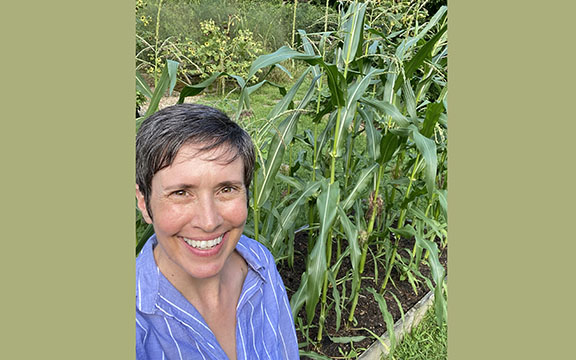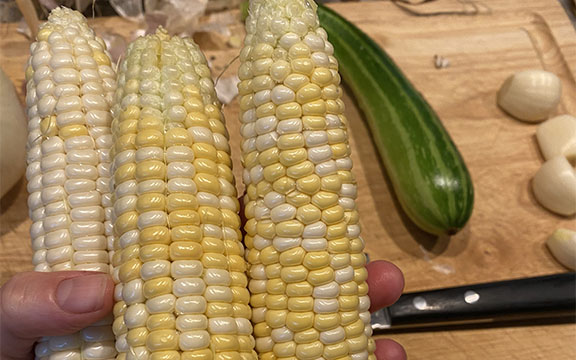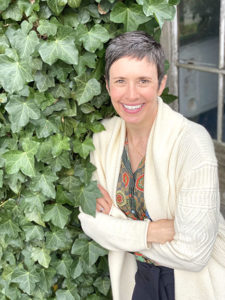
Photo: With the corn crop, harvest 2022.
I dropped the corn seeds in the furrow and wondered if they would grow. In the dark earth they glowed like citrine quartz; it seemed improbable that in two months the tiny dry seeds would grow into plants that would stand above my head. Many gardeners told me growing corn was not realistic for the suburban garden; too much effort for a small crop, too much water, too much luck required for pollination. Of course I could have believed the naysayers, but like most things that are sweet and satisfying, it would require me to use two tools from my Yoga arsenal: letting go of expectation and a dose of discipline.
My first attempt at growing corn was a total failure. I had picked up a dozen seedlings from a local nursery’s half-price section. They were thin and wispy, more dry than alive. But with my usual can-do—if rose-colored—attitude I figured they just needed some gardener’s TLC. But they failed to thrive and were so flimsy that the slightest wind knocked them over.
One blistering hot day I spent hours tying them to bamboo poles. But eventually the long skinny cobs yielded only a few ripe kernels. I tossed them on the compost heap and vowed to try again. But this summer seemed different. The corn germinated quickly and as the green blades poked up I wondered if our soil has memory. The original people of coastal Massachusetts, the Wampanoag tribe, farmed corn and beans intensely. Does our soil still recognize hands that cultivate with gratitude; does it welcome the seeds like old friends?
Summer brought heat and drought. Corn is thirsty and hungry so I hauled watering cans of seaweed emulsion fertilizer and drenched their foliage. I feed them from the sea in the way the local tribal ancestors had planted herring underneath to fertilize their growth.
Soon they grew to waist height, then above my head. I tried to be yogically non-attached and all that; but alternated between the curious neutrality of a practiced meditator and the rambunctious excitement of a kid during Christmastime.
It was a modest little bed; far from the fields of my youth. Growing up in northern Illinois meant corn took on a religious fervor. We’d drive past the fields and giddily wait until the first roadside stands appeared. My dad would buy bags of corn and after a quick dunk in boiling water, we’d get down to some serious eating. The sweet juice and butter ran down our arms in yellow rivulets and the only sounds in the dining room were the crunch and pop of each kernel bursting open; for one moment we tasted the fleeting essence of summer.
Finally my corn grew tall spikes with dangling flower droplets, followed by Rapunzel-gold tassels. Each silken thread ran down into the husk to produce a single kernel. August blazed forward and brought more heat and drought. I kept watering as the husks and tassels darkened. Finally the tassels dried and the outer husk turned leathery. Harvest time had arrived.

Photo: Prepping sweet corn soup in my kitchen.
I pulled down a husk to reveal a row of swollen kernels. Those little dried seeds had grown into hundreds of tiny fruits; each as swollen and lush as summer herself. I poked my thumbnail into the ear and was rewarded with a pop and spray of juice. Success. My practiced artifice of non-attachment vanished as I danced a jig right there in the garden. Pulling the husk open as crickets sang from the sunflower patch, I gobbled up half the ear right on the spot. In the moment, I realized that vairagya (non-attachment) and joy are not mutually exclusive—joy is the absence of clinging to a particular result, while appreciating whatever is arising moment to moment.
I gradually harvested and by the time of the Autumn Equinox it was time to pick the rest. I decided to have one last hurrah and make a large batch of sweet corn soup. I sautéed garlic and onions until soft. Then I added the mountain of corn, cumin, shallots, black pepper, and green chilies. “Wow,” my husband said, “smells so good in here.” We sprinkled the bowls with cilantro, tucked into one last summer supper, then licked the bowls clean.
Later that week my husband cut down the stalks and set them against the fence to dry. Soon we’ll tie them to the front porch railings and surround them with mums and pumpkins.
With nature as my teacher, I’m learning how to wield my Yoga tools: discipline to treat the earth with grateful hands; non-attachment to purely selfish desire for a good crop. If the earth sacrifices her fertility to grow the seed; if the seed sacrifices herself to grow the plant; if the plant sacrifices her fruit to me; then surely I can accept this offering and use it to serve others.
And, while I keep practicing with these tools, I celebrate the right to dance a jig in the garden in celebration of the sweet and satisfying success of a gardener’s winter dream come to life.
About the Author:
 Gita Brown is a wellness activist, musician, and writer. She is a certified Advanced Integral Yoga® teacher and licensed Yoga for the Special Child® practitioner. Through her “Yoga with Gita courses” and podcast, “The Gita Brown Show,” her mission is to teach her students how to adapt the traditional practices of Yoga to bring more ease, wellness, and joy into everyday life. Gita started Yoga as a teenager, when her love of Yoga grew in tandem with her career as a classical clarinetist and music therapist. For three decades, she has taught Yoga, wellness, and music courses at colleges, schools of music, community schools, private studios, public schools, and hospitals. She is currently finishing final revisions to her memoir. The story is about how she repurposed her wedding vows into a yogic vow to live love as a way of life—a pilgrimage that endured even as her husband and childhood sweetheart battled end-stage alcoholism. She offers Yoga to students of all ages and abilities through online programs and in person at her home studio at Three Dog Farm in Kingston, Massachusetts. Learn more about her services by visiting: https://www.gitabrown.com
Gita Brown is a wellness activist, musician, and writer. She is a certified Advanced Integral Yoga® teacher and licensed Yoga for the Special Child® practitioner. Through her “Yoga with Gita courses” and podcast, “The Gita Brown Show,” her mission is to teach her students how to adapt the traditional practices of Yoga to bring more ease, wellness, and joy into everyday life. Gita started Yoga as a teenager, when her love of Yoga grew in tandem with her career as a classical clarinetist and music therapist. For three decades, she has taught Yoga, wellness, and music courses at colleges, schools of music, community schools, private studios, public schools, and hospitals. She is currently finishing final revisions to her memoir. The story is about how she repurposed her wedding vows into a yogic vow to live love as a way of life—a pilgrimage that endured even as her husband and childhood sweetheart battled end-stage alcoholism. She offers Yoga to students of all ages and abilities through online programs and in person at her home studio at Three Dog Farm in Kingston, Massachusetts. Learn more about her services by visiting: https://www.gitabrown.com

